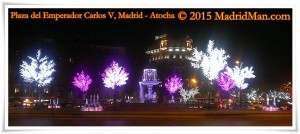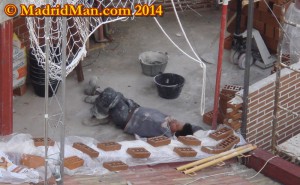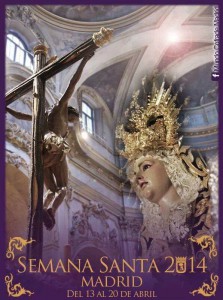The following is a “guest blog” by Susan from Michigan USA, her second guest blog on MadridMan’s Madrid Blog. The photos included are the property of Susan herself. DISCLAIMER: The comments and opinions expressed by our esteemed guest blogger do not necessarily reflect those of the blog’s host.
Seville was magical from the first moments. My travel companion and beloved Spanish professor, Señorita and I ventured out into the Barrio Santa Cruz, the former Jewish quarter in search of dinner at 8:30, early by Spanish standards. The Barrio is a maze of streets built centuries ago and much too small for cars so it remains a pedestrian-only destination. We found a small plaza with terraces from multiple restaurants spilling out and mingling together. As the sun set, we savored our meal, grilled shrimp swimming in garlic butter while sitting beneath the prolific orange trees that fill Seville with fragrance in early April. Emboldened by the rosé wine, I initiated a conversation in Spanish and she gave me a rundown of what to expect during our week in Seville. I had come with some trepidation about the crowds and the “Catholic-ness” of Holy week, known in Spain as “Semana Santa”.
Señorita told me that on her one previous visit to Seville for Holy Week, she and her travel companion had rushed to see every single one of the 50 processions as they exited their home parish churches. Since it was still the Franco era, the tourists had not yet invaded the city and transport between the local congregations was much simpler. We would struggle to crisscross the city if we wanted to see each procession depart and I didn’t want to spend all my time in the parades of Semana Santa. I wasn’t sure how to tell Señorita, but fate would set in.


Señorita and I were able to be about 10 rows from the edge of the crowd. As the hour wore on, we were trapped in a sea of people for yards in every direction, so close that with a slight movement, we could touch. The mingled scents of cologne, cigarette smoke, and garlic wafted in the air. The early April sun was already reminiscent of a hot summer day. The people in the crowd spoke only Spanish and all generations, the very young carried by their parents to the very old, sitting on portable chairs, gathered for this ancient tradition.
Mostly people were dressed in their Sunday best, often having matching outfits for their children. There were some jeans-clad teenagers with piercings and tattoos. Despite their rebellious appearance, they were fully respectful participants of the event, quieting down as the ancient doors to the church opened to reveal the first marchers, the Nazarenos.

Some of the churches have a special singer called a “Saeta” singer. This particular congregation hired a professional who came to the balcony as the Mary float was leaving the church. Although I did not understand the words of his song, the rich tones of his voice tore at my preconceptions of Holy Week. As a mother, I understood the traumatic loss of a beloved son. His deep voice floated down from the balcony as if he were heaven sent. Suddenly I saw Mary not as an intrusion to my overly puffed out Protestant beliefs, but rather as a grieving mother who had to watch her precious son die a horrible, painful, unjust death on a cross. Uncontrollably tears began to flow as I was consumed with grief at the sight of these beautiful people: Mary and Jesus, the cry of the singer, the heat of the noon day sun, the scent of the burning incense and the shower of flower petals falling from the rooftops. I was beginning to understand that in the most magnificent way, these Catholics were exalting our mutual Savior and His mother. I wanted to be a Catholic in that very moment.


Sevillanos spend the entire year preparing for this week, but if rain intervenes, the procession is canceled. The person who makes the decision is “damned if you do, damned if you don’t”. Nobody wants a cancellation but they can’t risk ruining the ornate and often ancient floats. Some date back hundreds of years. One afternoon we happened upon a procession as it was heading toward the nearby cathedral. As is the case, the marchers paused for a rest and suddenly, the skies opened and down came the rain. We had never seen a cadence with such a fast beat and the entire troupe jumped up and practically ran toward the protection of the cathedral.
My feelings about Holy Week and Catholicism took a 180 degree turn that week. I came with judgments about the “wrong” way Catholics portray Mary (as a Saint on par with Jesus) and Jesus (as a broken man on a cross, rather than the One who had victory over death). I saw Mary as a precious mother who loves tenderly. Since all the floats portrayed Jesus’ final week of life, the image of Jesus on the cross was a somber reminder of the price he paid for my salvation. Too often we Protestants scoot over the suffering Jesus experienced on our behalf. These Catholics reminded us that Jesus’ death came at a price.
People unabashedly worshipped Jesus and Mary in a very public way that I rarely saw at home. It was important enough to dress up and go out into the rain or heat to see the processions pass by. They honored tradition, but in doing so, honored God as well. Thousands of men and women marched in secret beneath the heavy robes, sometimes going barefoot as an act of penance. The Bible teaches that we are saved by faith, not by works, but the Apostle James in James 2:26 said, “Faith without works is dead.” I saw the faith and works entwined in the spectacle that is Holy Week. Semana Santa was one of the most incredible and historical spectacles I have ever witnessed.
(MadridMan message: Thank you, Susan, for the timely blog submission regarding your 2011 Holy Week experience in Seville, Spain. It was very well-written, insightful, detailed and clearly heart-felt.)
Related MadridMan Blog Entries: Semana Santa in Spain
Share THIS on Facebook!





Great post, Susan – we’ve only driven through Seville but your post makes me want to do a proper visit. And beautiful photos!
I loved your post and pictures. Makes me miss Europe!
Hi, Megan! The photo and guest-blog-post credits go to Susan from Michigan, USA. She did a great job!!
Thanks, Faith and Megan. Spain and Europe, with all their ancient traditions, surely do hold a special fascination for Americans.
Hi Susan,
I don’t know how I missed this entry! Beautiful description of Semena Santa. If it is all right, I would like to make copies and take to my Spanish class. A very thoughtful essay.
Elaine,
Thanks for your kind words! I would be honored for you to share this with your Spanish class.
Thanks, Susan. I will give it to my fellow students on Thursday night.